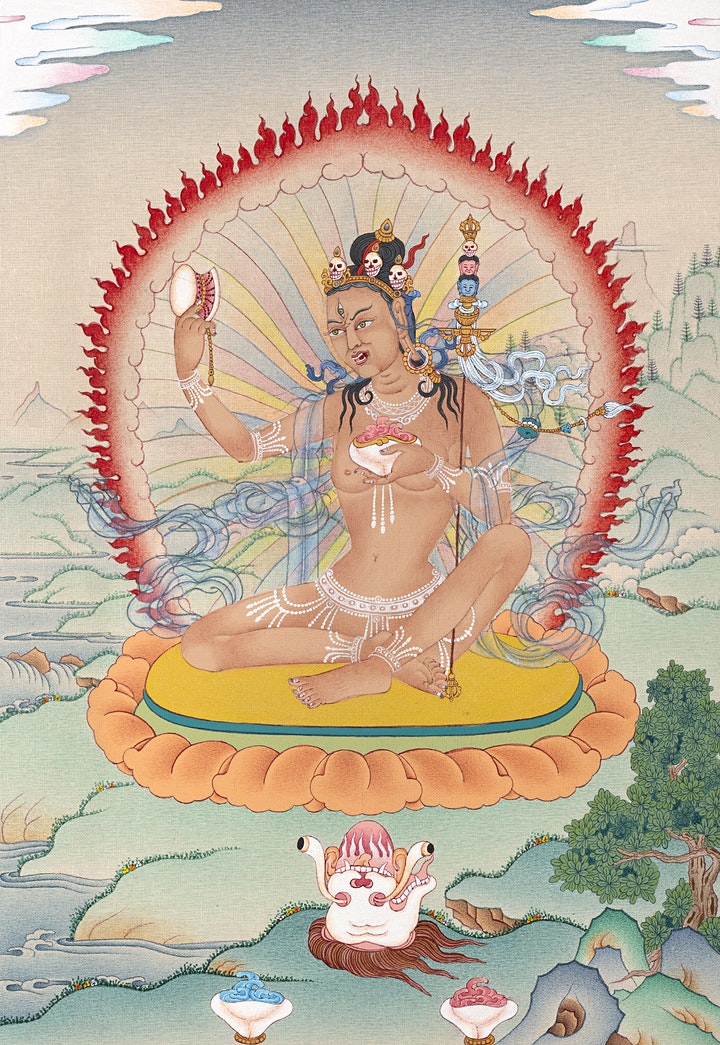
Q: Can she practice other Dharma practice from other lineage, after this, after this one [Niguma Yoga]?
A: Of course. Why? Why? There is no, there is no other Buddha, right? Only one Buddha Shakyamuni. Yeah. There’s only one 佛佗 [Buddha] right? That’s it. Long story short.
Because, like you see, like in the Shangpa Kagyu tradition, right? You see, རྩ་བ་ནི་གུ་ཆོས་དྲུག “rtsa ba ni gu chos drug”, རྩ་བ་ནི་གུ་ཆོས་དྲུག “rtsa ba ni gu chos drug” means the foundation of the Niguma teaching, there’s the Five Golden Dharmas of Niguma [“gser chos lnga”]. Foundation is Six Yogas of Niguma. Six Yogas of Niguma is རྩ་བ་ནི་གུ་ཆོས་དྲུག “rtsa ba ni gu chos drug” [Nigu Chö Druk].
And what is the Six Yogas of Niguma?
- First is Heat Generating Yoga practice, གཏུམ་མོ “tum mo”,
- སྒྱུ་ལུས “gyu lü”, སྒྱུ་ལུས “gyu lü” means Illusory Body and Mind practice (གཏུམ་མོ “tum mo”, སྒྱུ་ལུས “gyu lü”).
- And then the third is (གཏུམ་མོ “tum mo”, སྒྱུ་ལུས “gyu lü”) རྨི་ལམ་ “mi lam”, the Dream Yoga practice.
- And then (གཏུམ་མོ “tum mo”, སྒྱུ་ལུས “gyu lü”, རྨི་ལམ་ “mi lam”) འོད་གསལ་ “ö sel”, and then the Clear Light practice, almost like a lucid light practice. (གཏུམ་མོ “tum mo”, སྒྱུ་ལུས “gyu lü”, རྨི་ལམ་ “mi lam”, འོད་གསལ་ “ö sel”)
- འཕོ་བ་ “powa”, and then, the fifth one is འཕོ་བ་ “powa” practice, transmitting the state of the consciousness. Basically training yourself to be recognising the nature of the mind, long story short.
- And then (འཕོ་བ་ “powa”) བར་དོ་ “bar do”, you know, and then the Bardo practice, “life in between” practice. Okay?
So that’s the foundation of Niguma practice, and all of that has a preliminary practice within it. Okay? That’s number one. Now, that’s the Root of the tree, you know?
So the Niguma’s teaching is based on a tree:
- The Root of the Niguma’s teaching, is based on the, the foundation is the Six Yogas of Niguma,
- followed by the Trunk. So the Trunk is the Mahamudra teachings of Niguma, okay? So that’s the Mahamudra teaching (རྩ་བ་ནི་གུ་ཆོས་དྲུག “rtsa ba ni gu chos drug”) སྡོང་པོ་ཕྱག་རྒྱ་ཆེན་པོ། “dong po chak gya chen po”
- ཡལ་ག་ལམ་ཁྱེར་རྣམ་གསུམ། “yal kha lam khyer rnam gsum”, you know? The Branches are like, the three kayas inseparably practicing together (རྩ་བ་ནི་གུ་ཆོས་དྲུག “rtsa ba ni gu chos drug”, སྡོང་པོ་ཕྱག་རྒྱ་ཆེན་པོ། “dong po chak gya chen po”, ཡལ་ག་ལམ་ཁྱེར་རྣམ་གསུམ། “yal kha lam khyer rnam gsum”)
- མེ་ཏོག་མཁའ་སྤྱོད་དཀར་དམར། “me tog mkha’ spyod dkar dmar”, the Flowers are like the, you know, from the trees, there are the Red Dakini and the White Dakini. So they are more to do with the Phowa practice (རྩ་བ་ནི་གུ་ཆོས་དྲུག “rtsa ba ni gu chos drug”, སྡོང་པོ་ཕྱག་རྒྱ་ཆེན་པོ། “dong po chak gya chen po”, ཡལ་ག་ལམ་ཁྱེར་རྣམ་གསུམ། “yal kha lam khyer rnam gsum”, མེ་ཏོག་མཁའ་སྤྱོད་དཀར་དམར། “me tog mkha’ spyod dkar dmar”),
- འབྲས་བུ་འཆི་མེད་འཆུག་མེད། “bras bu ‘chi med chugs med”, and then the Seeds within the Flower is an infinite, timeless practice. So by that time, the whole idea of the visualisation becomes very subtle, almost like a colourless, objectless, sort of “beyond the deity image”.
Kyabje Kalu Rinpoche – Niguma Yoga Event in HK
Kadoorie Centre, Shek Kong, Hong Kong – Sunday 12th February 2023
To be continued …
Comments are closed.